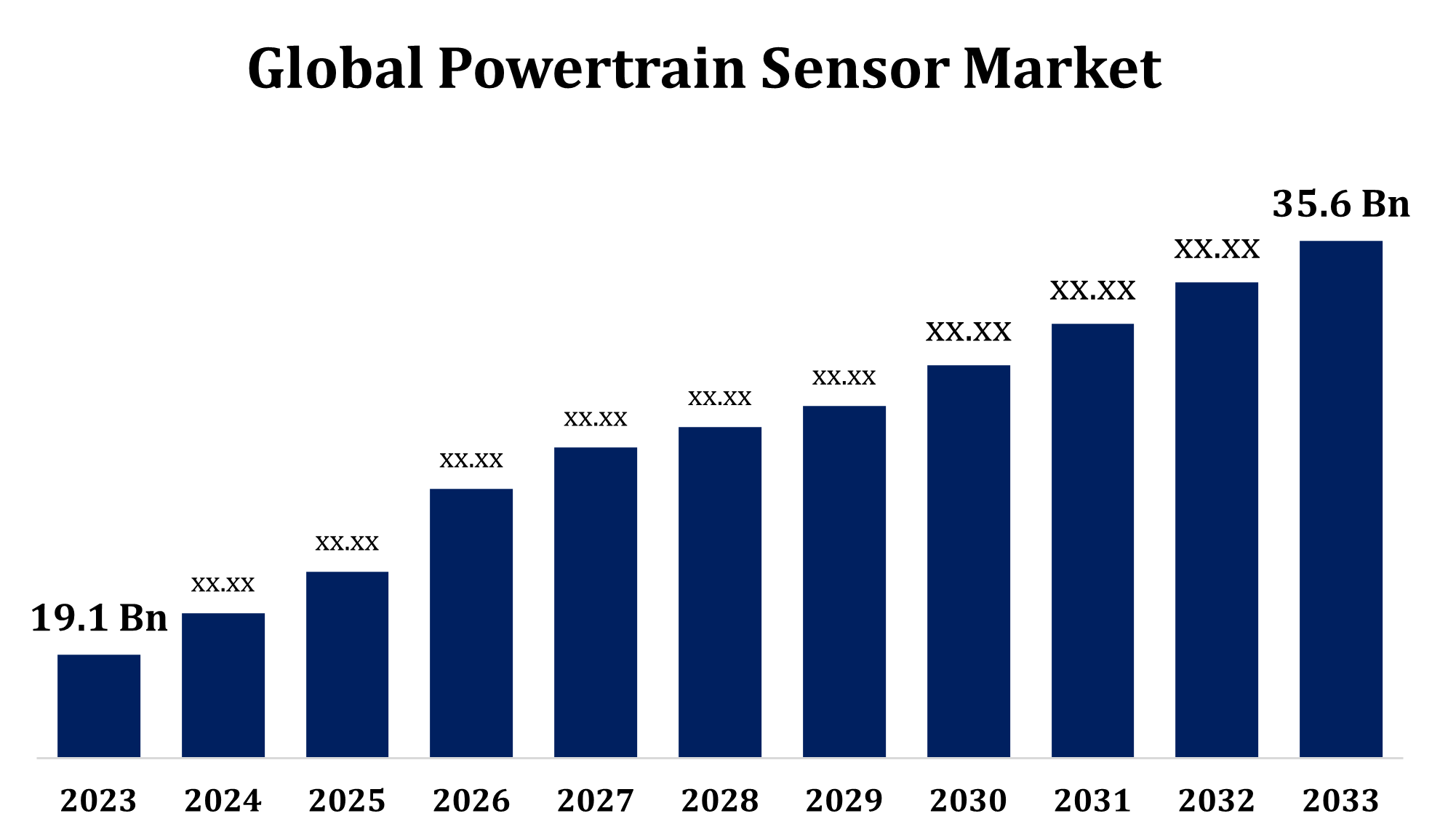Global Powertrain Sensor Market Size To Worth USD 35.6 Billion By 2033 | CAGR of 6.42%
Category: Automotive & TransportationGlobal Powertrain Sensor Market Size To Worth USD 35.6 Billion By 2033
According to a research report published by Spherical Insights & Consulting, the Global Powertrain Sensor Market Size to Grow from USD 19.1 Billion in 2023 to USD 35.6 Billion by 2033, at a Compound Annual Growth Rate (CAGR) of 6.42% during the forecast period.

Get more details on this report -
Browse key industry insights spread across 251 pages with 105 Market data tables and figures & charts from the report on the "Global Powertrain Sensor Market Size, Share, and COVID-19 Impact Analysis, By Powertrain Subsystem (Engine, Drivetrain, Exhaust), By Propulsion (ICE, EV), By Vehicle Type (Light-duty vehicle, Heavy-duty vehicle), and By Region (North America, Europe, Asia-Pacific, Latin America, Middle East, and Africa), Analysis and Forecast 2023 - 2033."Get Detailed Report Description Here: https://www.sphericalinsights.com/reports/powertrain-sensor-market
The powertrain sensor market is witnessing significant growth driven by the increasing demand for advanced automotive technologies, especially electric and hybrid vehicles (EVs). These sensors are essential for monitoring the performance and efficiency of powertrain systems, such as the engine, transmission, and driveline components. By providing real-time data on parameters like engine performance, temperature, pressure, and vibration, powertrain sensors help improve fuel efficiency, reduce emissions, and enhance vehicle safety. Factors such as rising automotive production, technological advancements in sensors, and a growing focus on sustainability are fueling this market. As the automotive sector transitions towards electrification, the demand for powertrain sensors, particularly in battery management systems and motor control, is expected to grow substantially in the coming years.
Powertrain Sensor Market Value Chain Analysis
The powertrain sensor market value chain consists of several stages, beginning with raw material suppliers who provide essential components like semiconductors and materials for sensor production. These materials are processed by sensor manufacturers, who design and create powertrain sensors for various automotive uses. Sensor manufacturers typically collaborate with OEMs (Original Equipment Manufacturers) and Tier 1 suppliers to incorporate sensors into vehicle powertrains, including those in electric, hybrid, and internal combustion engine systems. Once integrated, the sensors are supplied to automotive manufacturers for vehicle production. Aftermarket suppliers also play a significant role by offering replacement and upgraded sensors. In the final stage, vehicle end-users benefit from enhanced powertrain performance, efficiency, and safety, driving the demand for advanced sensors and solutions in the automotive industry.
Powertrain Sensor Market Opportunity Analysis
The powertrain sensor market offers significant opportunities driven by several key factors. The transition to electric and hybrid vehicles presents a major opportunity, as these vehicles require advanced sensors for battery management, motor control, and energy efficiency. Additionally, the growing demand for fuel-efficient and low-emission vehicles is prompting automakers to adopt advanced powertrain technologies, thereby increasing the need for precise sensors. Emerging markets with rising automotive production also present untapped potential for sensor adoption. Furthermore, advancements in sensor technologies such as wireless sensors, MEMS (Micro-Electro-Mechanical Systems), and IoT integration create new growth opportunities. The development of autonomous vehicles further opens avenues for sensors to enhance vehicle performance, safety, and real-time data analysis, further expanding market prospects.
The growing global production of motor vehicles is set to drive significant growth in the powertrain sensor market. As vehicle manufacturing continues to rise, especially with the increased demand for electric and hybrid vehicles, the need for advanced powertrain sensors becomes increasingly important. These sensors are crucial for optimizing vehicle performance, improving fuel efficiency, reducing emissions, and enhancing safety. The emphasis on sustainability and stricter emission regulations further boosts the adoption of advanced powertrain technologies, where sensors play a key role. Additionally, the expansion of the automotive industry in emerging markets offers new growth opportunities for powertrain sensor manufacturers. With vehicle production scaling to meet evolving consumer demands, the powertrain sensor market is poised for robust growth in the coming years.
A key challenge in the powertrain sensor market is the high cost of advanced sensors, particularly for electric and hybrid vehicles, which can increase the overall cost of the vehicle. Additionally, the complexity of integrating multiple sensors into modern powertrain systems, especially with the rise of electric and autonomous vehicles, presents significant technical hurdles. Variability in sensor quality and reliability, particularly in harsh operating conditions, can affect performance and durability. Another challenge is the constant need for innovation to keep pace with evolving automotive technologies, requiring substantial investment in research and development. Furthermore, the market faces supply chain disruptions and fluctuating raw material costs, which can impact sensor production and availability. These challenges create obstacles to wider market adoption.
Insights by Powertrain Subsystem
The engine segment accounted for the largest market share over the forecast period 2023 to 2033. The engine sub-system segment of the powertrain sensor market is seeing significant growth, driven by a greater emphasis on improving engine performance, fuel efficiency, and reducing emissions. Sensors in this sub-system are vital for monitoring critical parameters such as temperature, pressure, airflow, and exhaust gases, optimizing engine performance and ensuring adherence to stringent emission regulations. As electric and hybrid vehicles gain popularity, the demand for advanced sensors to monitor engine performance, battery management systems, and motor control is also increasing. Moreover, the trend toward more fuel-efficient internal combustion engines in traditional vehicles is further boosting growth in this segment. As manufacturers work to meet environmental standards and enhance vehicle efficiency, the engine sub-system segment is expected to maintain strong growth in the powertrain sensor market.
Insights by Propulsion
The ICE propulsion segment accounted for the largest market share over the forecast period 2023 to 2033. Despite the growing popularity of electric vehicles, internal combustion engine (ICE)-powered vehicles continue to dominate in many regions, driving sustained demand for advanced sensors. These sensors are crucial for optimizing engine performance, fuel efficiency, emissions control, and overall vehicle safety. They monitor key parameters such as air-fuel ratio, exhaust gas temperature, pressure, and engine vibrations to ensure the engine operates efficiently. As global environmental regulations become stricter, the demand for more accurate sensors to manage emissions and enhance fuel economy has increased. The ongoing development of more efficient and reliable ICE technologies further supports growth in this segment, making it an essential component of the broader powertrain sensor market.
Insights by Vehicle Type
The heavy duty vehicles segment accounted for the largest market share over the forecast period 2023 to 2033. The growth of the powertrain sensor market in heavy-duty vehicles (HDVs) is driven by the increasing need for advanced sensor technologies to enhance performance, efficiency, and safety. Sensors in HDVs are essential for monitoring engine parameters, transmission performance, fuel efficiency, and emissions, ensuring compliance with stringent environmental regulations. Given the critical role HDVs play in logistics, transportation, and industrial sectors, there is a rising demand for more reliable and durable powertrain sensors. The growing focus on reducing carbon emissions and improving fuel economy in HDVs further accelerates sensor adoption. Additionally, the shift toward hybrid and electric technologies in large trucks and buses is fueling the need for specialized sensors. As the global HDV fleet expands, the powertrain sensor market in this segment is poised for rapid growth.
Insights by Region

Get more details on this report -
North America is anticipated to dominate the Powertrain Sensor Market from 2023 to 2033. The powertrain sensor market in North America is experiencing significant growth, driven by the region's strong automotive industry, technological advancements, and the rising adoption of electric vehicles (EVs). The demand for advanced powertrain sensors is fueled by the need to improve fuel efficiency, reduce emissions, and enhance vehicle performance. North America's commitment to sustainability and stricter emission standards further supports the integration of cutting-edge sensor technologies in both traditional and electric powertrains. The presence of leading automotive manufacturers and Tier 1 suppliers in the region also accelerates market growth. Moreover, the growing interest in autonomous vehicles and connected car technologies creates new opportunities for powertrain sensors in North America. As vehicle production continues to rise, the market is expected to grow steadily, positioning North America as a key region for sensor manufacturers.
Asia Pacific is witnessing the fastest market growth between 2023 to 2033. The powertrain sensor market in the Asia Pacific region is experiencing rapid expansion, driven by the increasing vehicle production, especially in emerging economies. The growing demand for electric and hybrid vehicles is a key factor, as these vehicles rely on advanced powertrain sensors for optimal performance and energy efficiency. Additionally, the region is home to numerous leading automotive manufacturers and an expanding network of Tier 1 suppliers, which further boosts market demand. Asia Pacific's emphasis on reducing emissions and enhancing fuel efficiency aligns with the widespread adoption of innovative sensor technologies. Furthermore, the expanding automotive sector in emerging markets provides new opportunities for sensor manufacturers. With rising vehicle production and ongoing technological advancements, the Asia Pacific market is set for substantial growth.
Recent Market Developments
- In October 2019, Melexis has broadened its precision pressure sensor portfolio with the introduction of new analog output sensor ICs, the MLX90817 and MLX90818. These sensors represent a major leap forward in terms of accuracy, size, and flexibility, playing a vital role in making future engines cleaner and more efficient than existing models.
Major players in the market
- Continental AG
- Robert Bosch GmbH
- DENSO CORPORATION
- HELLA GmbH & Co. KGaA
- VALEO SERVICE
- Mitsubishi Electric Automotive America Inc.
- Infineon Technologies AG
- Texas Instruments Incorporated
- NXP Semiconductors
- TE Connectivity.
- Littelfuse, Inc.
- Allegro MicroSystems, Inc.
- TDK-Micronas GmbH
- Melexis
- HYUNDAI KEFICO Corporation
- PCB Piezotronics, Inc.
- Kyocera
- Murata Manufacturing Co., Ltd
Market Segmentation
This study forecasts revenue at global, regional, and country levels from 2023 to 2033.
Powertrain Sensor Market, Powertrain Subsystem Analysis
- Engine
- Drivetrain
- Exhaust
Powertrain Sensor Market, Propulsion Analysis
- ICE
- EV
Powertrain Sensor Market, Vehicle Type Analysis
- Light-duty vehicle
- Heavy-duty vehicle
Powertrain Sensor Market, Regional Analysis
- North America
- US
- Canada
- Mexico
- Europe
- Germany
- Uk
- France
- Italy
- Spain
- Russia
- Rest of Europe
- Asia Pacific
- China
- Japan
- India
- South Korea
- Australia
- Rest of Asia Pacific
- South America
- Brazil
- Argentina
- Rest of South America
- Middle East & Africa
- UAE
- Saudi Arabia
- Qatar
- South Africa
- Rest of the Middle East & Africa
About the Spherical Insights & Consulting
Spherical Insights & Consulting is a market research and consulting firm which provides actionable market research study, quantitative forecasting and trends analysis provides forward-looking insight especially designed for decision makers and aids ROI.
Which is catering to different industry such as financial sectors, industrial sectors, government organizations, universities, non-profits and corporations. The company's mission is to work with businesses to achieve business objectives and maintain strategic improvements.
CONTACT US:
For More Information on Your Target Market, Please Contact Us Below:
Phone: +1 303 800 4326 (the U.S.)
Phone: +91 90289 24100 (APAC)
Email: inquiry@sphericalinsights.com, sales@sphericalinsights.com
Contact Us: https://www.sphericalinsights.com/contact-us
Need help to buy this report?